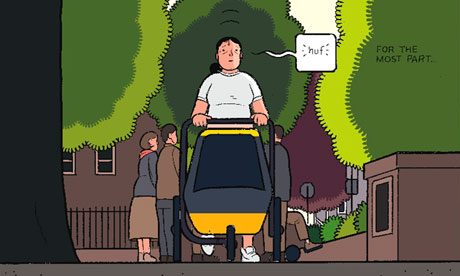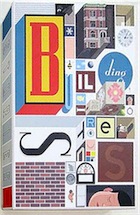JANUARY 3, 2013
COVER STORY: “THRESHOLD”

On December 14th, I helped chaperone my daughter’s second-grade-class field trip to a local production of “The Nutcracker,” where I spent most of my time not watching the ballet but marvelling at the calm efforts of the teacher to keep the yelling, excited class quieted down. Teaching was not, I concluded at one point, a profession in which I could survive for even one day. Our buses came back to the school at midafternoon, and I and the other volunteer parents left our children for another hour of wind-down time (for us, not them) before returning for the regular 3-P.M. pickup. I came home, however, not to any wind-down but to the unfolding coverage of the Newtown shooting. Shaken to the core, I returned to the school, where a grim quiet bound myself and the other parents together, the literally unspeakable news sealing our smiles while, at a lower strata, our happy, screaming children ran out of the building into our arms still frothed up by sparkling visions of the Sugar Plum Fairy.
My wife is a public-high-school teacher in Chicago, and though there has never been a shooting in her school during her tenure, there have been fights and thefts. Shootings have occurred outside and near her school, and one student died last year. A metal detector cowls the single student entrance. Such a safeguard, including two real guards—Chicago police, with guns—have been put in place (as at most Chicago public schools) because of gang unrest from within, not Playstation-style nightmares from without. Needless to say, rarely does a day pass where I don’t pray to my vague, atheist-default Supreme Ruler of the Universe that everything go effing well for her.
In the course of the next few days, I was privy to the exchanges among my wife and her colleagues about Newtown, culminating in flabbergasted e-mails and Facebookings following the farcical N.R.A. press conference. Memes abounded, like, “First they call us union thugs and now they want to arm us?!” and self-mocking jokes about their own forgetfulness: “Do you really want to trust people like us with guns?” (Teachers are notoriously overworked and so occasionally forget their two pounds’ worth of keys in one classroom or another.) What astonished me most was that the gun lobby seemed to imply that it was somehow partly the unarmed teachers’ fault that the Newtown shooting occurred at all. Well, why not? Isn’t everything lately always somehow the teachers’ fault?
Meanwhile, our government revved its engines to Evel-Knievel itself over the fiscal cliff, civilization’s rock face having partly crumbled away because a clot of representatives seem to feel that government shouldn’t be funded at all. Over the holiday break, news arrived that thirty-seven Philadelphia public schools were closing because of budgetary cuts, and meanwhile the whole idea of public education continues to be cored out nationwide by taxpayer-funded private “charter” schools in a sleight of hand that I still can’t believe is legal. (Meanwhile, my union-thug wife is too busy grading papers and planning lessons to be able to get properly mad about it all.)
In September, I pictured, more or less, my daughter’s teacher and her class on a “back to school” cover (click to expand) that jokingly pointed to the free time that parents would have now that their kids were back in class; it was something I saw every morning, and I thought it would make a sort of funny picture. In the wake of Newtown, it didn’t seem so funny anymore. As parents and citizens, we entrust our children not only to the safety of schools but also to the nurturing and cultivated environment of schools and teachers. Education is the very foundation of civilization and cannot be undermined or undersold. That we now have to somehow consider an unchecked population of firearms as part of this equation seems absolutely ludicrous and terrifying.
KEYWORDS
To get more of The New Yorker's signature mix of politics, culture and the arts: Subscribe Now
- MOST POPULAR
- MOST E-MAILED
- THIS ISSUE
- Andy Borowitz: Obama Urged to Resign Over Beyoncé Scandal
- Sasha Weiss: Why We Care About Beyoncé
- Mina Kaneko and Francoise Mouly: Cover Story: Jorge Colombo’s iPad Finger Paintings
- Amy Davidson: Michelle Obama’s Dress: Victory Red
- David Denby: “Django Unchained”: Put-On, Revenge, and the Aesthetics of Trash
MORE FROM THE NEW YORKER
Read more: http://www.newyorker.com/online/blogs/culture/2013/01/chris-wares-newtown-inspired-cover-for-the-new-yorker.html#ixzz2Iz5N5hUV
Building Stories by Chris Ware – review
Chris Ware's innovative book-in-a-box lays bare the everyday misery of home life

'A thing to be treasured': Building Stories by Chris Ware. Photograph: Chris Ware/Jonathan Cape
Chris Ware's new graphic novel comes in a cardboard box, like BS Johnson's The Unfortunates, or an old-fashioned board game. Inside, are 14 "distinctively discrete" books and pamphlets of varying sizes. Each one of these stands alone, and since – in theory – they may be read in any order, several members of a comic-loving family could happily read Building Stories over the course of the same afternoon. But they work together, too, combining to depict, in rich and multifaceted fashion, the mostly unhappy lives of the inhabitants of a single Chicago apartment block. Ware's box, then, isn't a gimmick, but a sort of proxy. Like the crumbling building at his story's heart, it's a repository of misery, loneliness and misunderstandings. As Philip Larkin had it: "Home is so sad."
On the ground floor of the building is the old lady who owns it. She inherited it from her parents, at which point her spinsterhood, which might have been only temporary, calcified into permanence. Above her is a young couple. He works nights, the better to avoid his girlfriend, whose weight gain repulses him. He's a vile man, his muffled insults seeping through the building's too-thin floors. But his girlfriend makes it too easy for him to behave badly, trapped as she is in a waiting room of futile hope (every weekend, or so she thinks, is the one when he'll start being nice to her again). When he tells her that he despises her trousers or her skirt, she wriggles out of them obediently, as if by shedding her clothes she will also shed her misery. Finally, there's the top floor, which is rented by a young, single art student (well, she's young and single in some of the books, and not-so-young and not-so-single in others), and it's with this woman, who lost her left leg below the knee as a child, that you feel Ware's interest really lies. When I opened one of the 14 books, and found she wasn't in it, I felt disappointed, longing to get back to her.
Ware's trademark frames are tiny and rigid, confining his characters every bit as much as their too-small bathrooms and their stifling romantic lives. But they also, in this instance, call to mind windows; Building Stories is such an intimate book that to read it is to feel like a Peeping Tom. Lives are thrown wide open, the private moments no one ever sees brought carefully out into the light. A lavatory floods, and induces in its owner an existential crisis. A woman tries, and fails, to do up her jeans. Another woman inserts a tampon. Ware's drawings of people, all dots and circles, are rudimentary on the face of it – and yet no emotion is beyond him. It's amazing, this economy. Even more deft, sometimes he will use some other body part to do the work of a frown, a wince, or a pair of lips pressed tightly together. A woman's waddling backside, huge in tight red trousers, tells a story of repressed anger; a man's flaccid penis – yes, really – somehow articulates all the pressures of recessionary middle-age. As for his apartment building, it constantly underscores the book's theme: the gap between what people hope for, and what they get. Home, as Larkin also had it, starts out as a "joyous shot at how things ought to be". Then it withers. Larkin could see it in the pictures and the cutlery. Ware sees it in a plastic shower curtain and a mustard‑coloured armchair. Never before has such a brightly coloured book been so mournful.
I don't want to give the impression that Building Stories is without its faults. On a practical level, older – ahem – comic lovers will sometimes struggle to read Ware's miniature writing, and I must be honest and say that I would rather have been told the best order in which to read its sections (there certainly is one, and I think it's pointless to pretend otherwise). Confusion about past and present sometimes distracts from the deep pleasures of the crammed page. But still, this is a wonderful achievement. It's not only that it is so beautifully and attentively made – though in the age of the Kindle, and of all things disposable, Ware is certainly making a powerful statement. No, it's the sense of belief that gets to you, the absolute commitment to the form. Building Stories does things no traditional novel can, or not without much lumbering effort; and it does other things no comic has hitherto pulled off. No wonder, then, that opening it for the first time makes you feel like a child at Christmas. It's a thing to be treasured, a box of delights.

































Comments
15 COMMENTS |